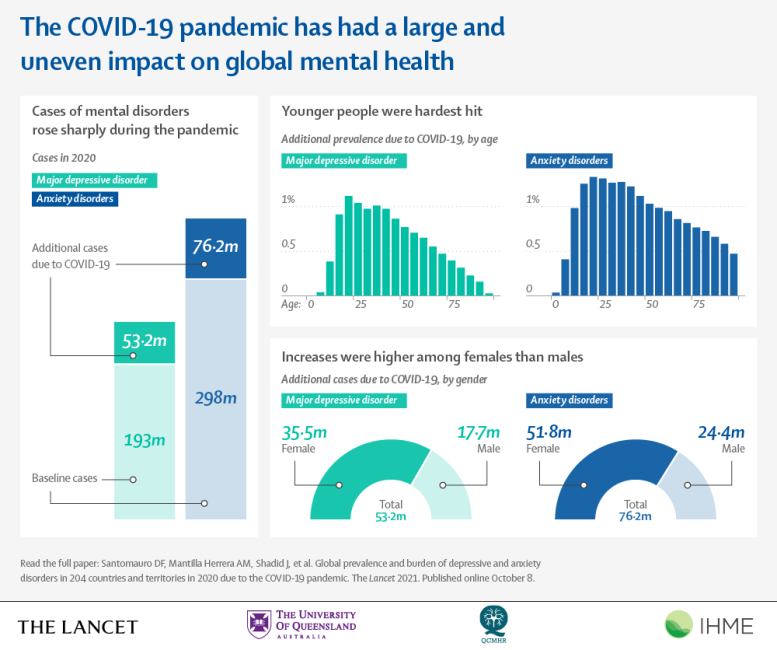
COVID-19 pandemic led to stark rise in depressive and anxiety disorders globally in 2020, with women and younger people most affected. Credit: The Lancet
- First global estimates of the impact of the COVID-19 pandemic on mental health in 2020 suggest additional 53 million cases of major depressive disorder and 76 million cases of anxiety disorders were due to the pandemic.
- Women and younger people were the most affected by major depressive disorder and anxiety disorders in 2020.
- Countries hit hardest by the pandemic in 2020 had the greatest increases in cases of major depressive disorder and anxiety disorders.
- The authors call for urgent action by governments and policy makers to strengthen mental health systems globally to meet increased demand due to the pandemic.
Cases of major depressive disorder and anxiety disorders increased by more than a quarter worldwide in 2020 due to the COVID-19 pandemic, according to the first global estimates of the impacts of the pandemic on mental health, published in The Lancet.
In 2020, cases of major depressive disorder and anxiety disorders increased by 28% and 26%, respectively. Women were affected more than men, and younger people were more affected than older age groups. Countries with high COVID-19 infection rates and major reductions in the movement of people – a consequence of measures such as lockdowns and school closures – had the greatest increases in prevalence of major depressive disorder and anxiety disorders.
Even before the COVID-19 pandemic, major depressive disorder and anxiety disorders – which can increase the risk of other health outcomes such as suicide – were major contributors to the global burden of disease, affecting millions of men and women of all ages around the world.
Lead author Dr Damian Santomauro, of the Queensland Centre for Mental Health Research, School of Public Health, University of Queensland, Australia, said: “Our findings highlight an urgent need to strengthen mental health systems in order to address the growing burden of major depressive disorder and anxiety disorders worldwide. Promoting mental wellbeing, targeting factors contributing to poor mental health that have been made worse by the pandemic, and improving treatment for those who develop a mental disorder should be central to efforts to improve support services. Even before the pandemic, mental health-care systems in most countries have historically been under-resourced and disorganized in their service delivery. Meeting the added demand for mental health services due to COVID-19 will be challenging, but taking no action should not be an option.”
Until now, no studies had analyzed the global impact of the COVID-19 pandemic on the prevalence of major depressive disorder and anxiety disorders in 2020. Most previous work consisted of surveys in specific locations over a short time period.
The new study is the first to assess the global impacts of the pandemic on major depressive disorder and anxiety disorders, quantifying the prevalence and burden of the disorders by age, sex, and location in 204 countries and territories in 2020.
A systematic literature review was performed to identify population survey data published between January 1, 2020, and January 29, 2021. Eligible studies reported prevalence of depressive or anxiety disorders that were representative of the general population and had a pre-pandemic baseline. Using a disease modeling meta-analysis tool, data from eligible studies was used to estimate changes in the prevalence of major depressive disorder and anxiety disorders due to COVID-19 based on age, sex, and location, including in locations for which no eligible studies were available. Estimates of daily COVID-19 infection rate and movement of people were used as indicators of the impact of the pandemic on populations.
The systematic review identified 5,683 unique data sources, of which 48 (one of which reported across two regions) met inclusion criteria. Most studies were from Western Europe (22) and high-income North America (14), with others from Australasia (5), high-income Asia Pacific (5), East Asia (2), and central Europe (1).
The meta-analysis indicates that increased COVID-19 infection rate and reduced movement of people were associated with increased prevalence of major depressive disorder and anxiety disorders, suggesting that countries hit hardest by the pandemic in 2020 had the greatest increases in prevalence of the disorders.
In the absence of the pandemic, model estimates suggest there would have been 193 million cases of major depressive disorder (2,471 cases per 100,000 population) globally in 2020. However, the analysis shows there were 246 million cases (3,153 per 100,000), an increase of 28% (an additional 53 million cases). More than 35 million of the additional cases were in women, compared with close to 18 million in men.
Model estimates suggest there would have been 298 million cases of anxiety disorders (3,825 per 100,000 population) globally in 2020 had the pandemic not happened. The analysis indicates there were in fact an estimated 374 million cases (4,802 per 100,000) during 2020, an increase of 26% (an additional 76 million cases). Almost 52 million of the additional cases were in women, compared with around 24 million in men.
Younger people were more affected by major depressive disorder and anxiety disorders in 2020 than older age groups. The additional prevalence of these disorders peaked among those aged 20-24 years (1,118 additional cases of major depressive disorder per 100,000 and 1,331 additional cases of anxiety disorders per 100,000) and declined with increasing age.
Co-author Alize Ferrari, GBD mental disorders team lead at the Queensland Centre for Mental Health Research, School of Public Health, University of Queensland, Australia, said: “The COVID-19 pandemic has exacerbated many existing inequalities, and social determinants of mental health. Sadly, for numerous reasons, women were always more likely to be worse affected by the social and economic consequences of the pandemic. Additional caring and household responsibilities tend to fall on women, and because women are more likely to be victims of domestic violence, which increased at various stages of the pandemic.
“School closures and wider restrictions limiting young people’s ability to learn and interact with their peers, combined with the increased risk of unemployment, also meant that young people were also more heavily impacted by major depressive disorder and anxiety disorders during the pandemic. It is crucial that policymakers take underlying factors such as these into account as part of measures to strengthen mental health services.”
The authors acknowledge that their study was limited by a lack of high quality data on the effects of COVID-19 pandemic on mental health in many parts of the world, particularly low- and middle-income countries. As a result, they say extrapolated estimates generated for countries where data was lacking should be interpreted with caution, and call for improved data coverage and quality globally. Most available data was based on self-reported symptom scales that only estimate probable cases of major depressive disorder and anxiety disorders. More data from diagnostic mental health surveys representative of the general population – of which only three covered the study period – will improve understanding of the pandemic’s effects on mental health. The prevalence of other mental disorders – such as eating disorders – might also have been affected by the COVID-19 pandemic, and the authors say these should be assessed as new mental health surveys are undertaken.
Writing in a linked Comment, Dr Maxime Taquet and Professor Paul Harrison, from the University of Oxford, and Professor Emily Holmes, from Uppsala University and the Karolinska Institute, who were not involved in the study, said: “The first global insight into the burden of depressive and anxiety disorders during the pandemic by Santomauro and colleagues starkly highlights the impact of the pandemic on mental health globally.” They echo the study authors’ calls for action to strengthen mental health systems, saying: “The study should therefore urgently incentivize more research to determine the fuller geographic distribution of depression and anxiety, the prevalence of depressive and anxiety disorders, and the underpinning mechanisms to improve mental health in the context of the COVID-19 pandemic globally.”
Reference: “Global prevalence and burden of depressive and anxiety disorders in 204 countries and territories in 2020 due to the COVID-19 pandemic” by COVID-19 Mental Disorders Collaborators, 8 October 2021, The Lancet.
DOI: 10.1016/ S0140-6736(21)02143-7
This study was funded by Queensland Health, National Health and Medical Research Council, and The Bill and Melinda Gates Foundation. It was conducted by researchers from the University of Queensland, Queensland Centre for Mental Health Research, Australia, and University of Washington School of Medicine, USA.









I wonder if its the amount of fear based propaganda the media produces or are people suffering these anxieties from the weight of social and economic coercion to be a gene therapy test subject for a disease with 99.9 survival? Prolonged stresses are detrimental to health and we are being stress tested for a controlled society. If we were a truly free and scientific society we would be having honest conversations about the causes of our health issues like diet, lifestyles and the still ongoing fukushima situation and its effects. The covid scam is not the cause of fish stocks collapsing or is it? To much is being censored.
COVID doesn’t have a 99.9 survival rate. It has closer to 3% fatality rate. It has at least 6x higher of a death rate than the flu. Most of those people are elderly or have compromised immune systems. If you say that they’re “sick anyway” that really says something about you as a person. Elderly people that can’t use a computer have to buy food too, you know. COVID isn’t a scam. If you think it is, just visit your local hospital’s COVID ward and I think you’ll find out pretty quick it isn’t. 1,050,000 dead Americans. Even if you think that number is inaccurate, if just 1/10 of those died directly from covid that’s still over 100,000. An average flu season kills around 12,000.